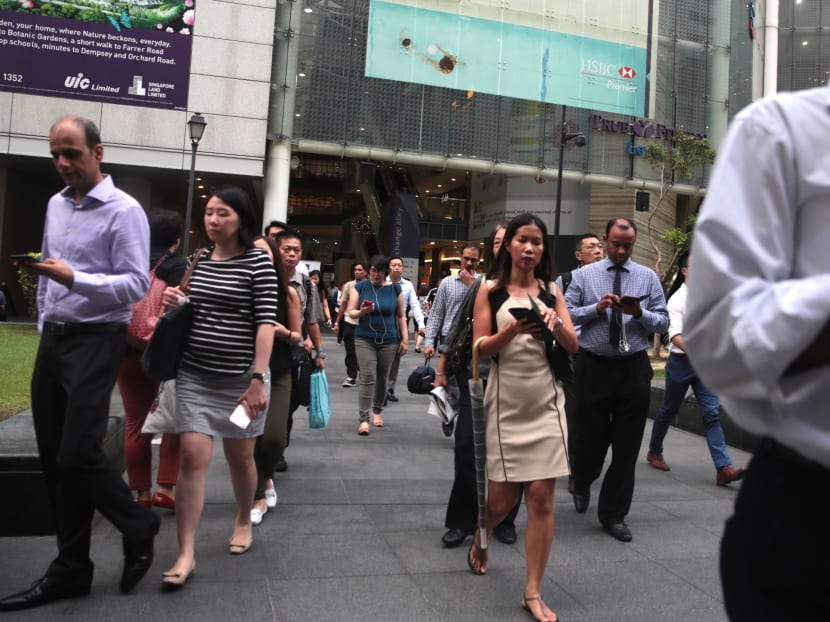Hiring more restrained, wage growth expected to ease as labour market softens: MAS
SINGAPORE — Singapore's labour market is expected to soften and employers are likely to become more cautious in hiring workers amid a slowdown in the economy, the Monetary Authority of Singapore (MAS) warned on Wednesday (Oct 30).

The Monetary Authority of Singapore said wage growth is expected to slow down this year and next, as compared with 2018.
SINGAPORE — Singapore's labour market is expected to soften and employers are likely to become more cautious in hiring workers amid a slowdown in the economy, the Monetary Authority of Singapore (MAS) warned on Wednesday (Oct 30).
As a result, wage growth is expected to slow down this year and next as compared with 2018, said the central bank in its biannual macroeconomic review.
This latest prognosis comes after manpower figures released last week showed that overall employment continued to expand in the first half of 2019, as hiring in the modern services and domestic-oriented clusters had offset the loss of jobs in trade-related sectors of the economy.
The trade-related sector, which involves the electronics and wholesale trade industries, has been hit by persistent global trade restrictions, brought about by the ongoing trade war between the United States and China, as well as other global factors such as a drop in demand for electronics.
Singapore, as a highly trade-dependent economy, is not spared from these effects, the MAS noted.
The MAS report highlighted how in economic downturns over the last 20 years, global electronics sector shocks have had the most significant impact on the domestic economy.
"The impact of the shocks was mainly absorbed by declines in firms' profitability, before labour costs were reduced through wage adjustments and a scaling back of employment," said the MAS of these past downturns.
While companies are more hesitant to hire and the sentiment could be further dampened amid an economic slowdown, the MAS noted that employers have so far chosen to retain their existing workers.
Compared with past years, retrenchment rates this year have remained relatively low. The latest statistics from the Ministry of Manpower showed a total of 5,550 workers laid off in the first half of this year.
The MAS also noted that the ongoing slowdown in the electronics sector has not spilled over into an economy-wide downturn.
Still, it said shifts in business confidence, hiring intentions and the ease of access to borrowing should continue to be monitored as “early indicators of a broadening or weakening dynamic”.
The current downswing in the global electronics cycle is a large drag on trade-related industries, causing growth of Singapore’s economy to slow significantly over the past six months, said the MAS.
In the second and third quarters this year, the economy expanded by an average of 0.1 per cent year-on-year, whereas in each of the previous two quarters the economy had grown by 1.2 per cent on average.
Modern services, such as the infocomm technology, finance and insurance sectors, were the main growth drivers of the domestic economy, while the trade-related cluster continued to suffer from declines in the past two quarters.
This drop was particularly sharp in the semiconductor manufacturing segment, reflecting the supply glut in the global chips market, weak demand for semiconductor equipment and other factors, the report said.
“Alongside persistent external uncertainties, the domestic economy could experience fits and starts for the rest of the year and into 2020. Growth will be uneven across the economy, with the modern services and domestic-oriented clusters offsetting the weakness in the trade-related cluster,” said the report.
Describing the economic outlook as “an extended trough”, the Singapore economy is expected to grow between 0 and 1 per cent in 2019, and then improve modestly in 2020, the MAS said.
This is in line with the forecast previously announced by the Ministry of Trade and Industry in August.
MIXED PICTURE
Analysts speaking to TODAY painted a mixed picture for the labour market.
Mr Matthieu Imbert-Bouchard, managing director of recruitment agency Robert Half Singapore, said that the cyclical downturn in economic growth rates is showing up in recent labour trends, such as a marginal increase in unemployment, stagnant job vacancy rates across most sectors, as well as a reduced pace of salary growth, though he said there is no expectation of salary reductions.
It is not all bleak, however, as workers in growing sectors, such as in infocomm technology and finance, will continue to be in demand, he added.
But as these sectors require specialised skills, there has been an ongoing talent and skills shortage for the past five years, Mr Imbert-Bouchard said.
“While there might be no shortage of jobseekers in the market, they may not bring the advanced technical skill requirements businesses need to meet their long-term transformation goals.”
Dr Tan Khay Boon, senior lecturer at SIM Global Education, agreed, adding that the mismatch between skills and job vacancies is likely to worsen as trade-related industries, such as manufacturing, get hit harder than the rest of the economy.
“For the time being, there is no strong evidence of a spillover effect from the manufacturing sector to the rest of the economy, especially the services sector, hence no major retrenchment is expected at this stage,” said Dr Tan.
Ms Selena Ling, OCBC’s head of treasury research and strategy, said that a moderation of wages is expected and healthy, adding that she would have been worried if MAS did not expect wage growth to ease.
“Because then we would have an overall cost competitiveness issue that will impact businesses… which might even need to retrench as a result,” said Ms Ling in a phone interview.
She said there is still some hope for a turnaround in the trade war, with the US most recently saying it would delay a planned tariff increase of 25 to 30 per cent on US$250 billion of Chinese goods.
“The stars are aligning for the US-China trade deal to be signed in the near term… Markets take that as a sign (for improved trade relations),” she said.
Even then, the “million-dollar question” for 2020 is whether there will be an improvement in global growth prospects and whether Singapore, too, will rebound.
Said Ms Ling: “At this juncture (for Singapore), it looks to be a muted recovery story.”








